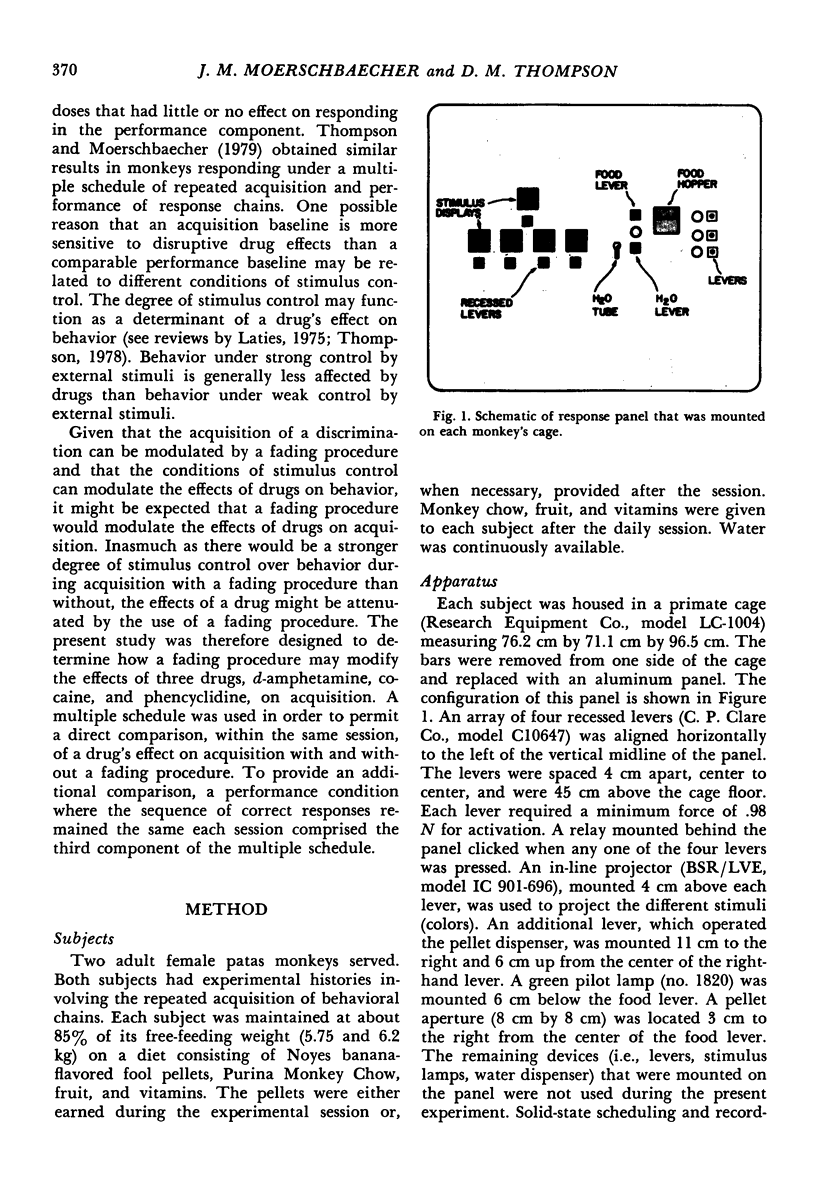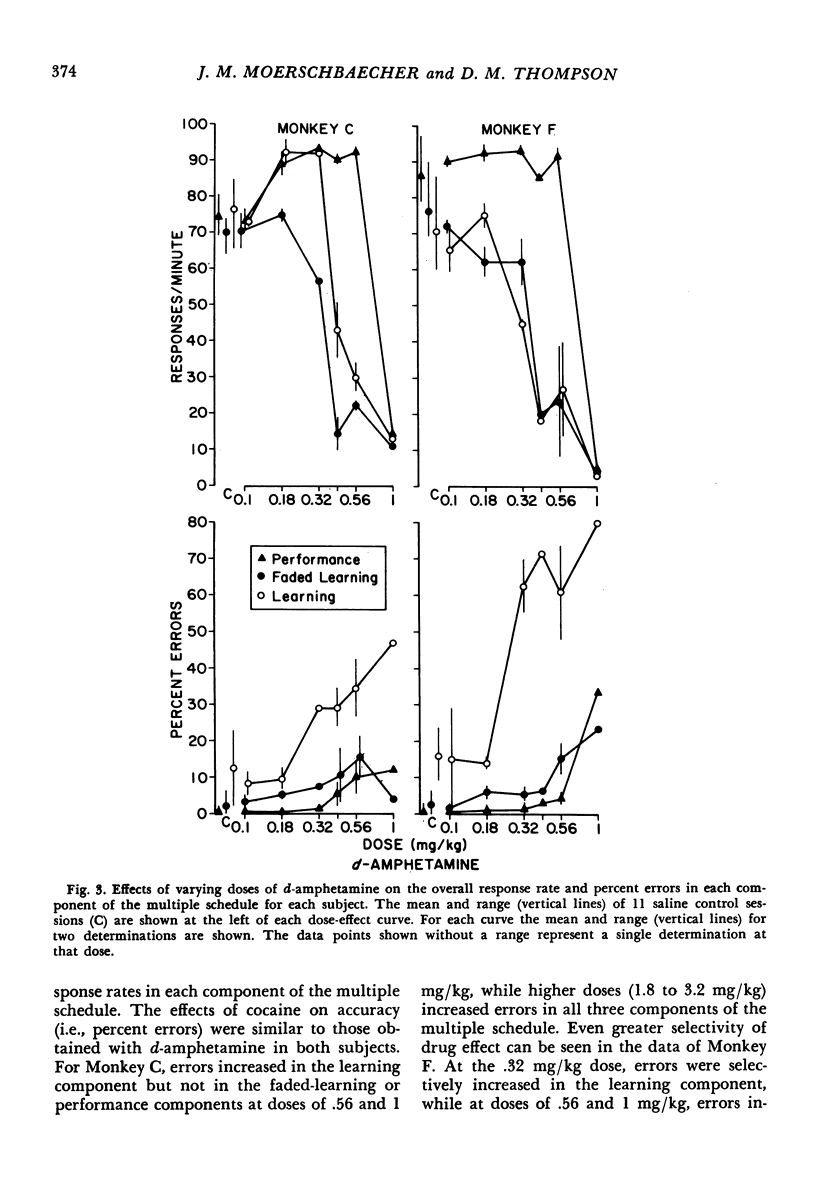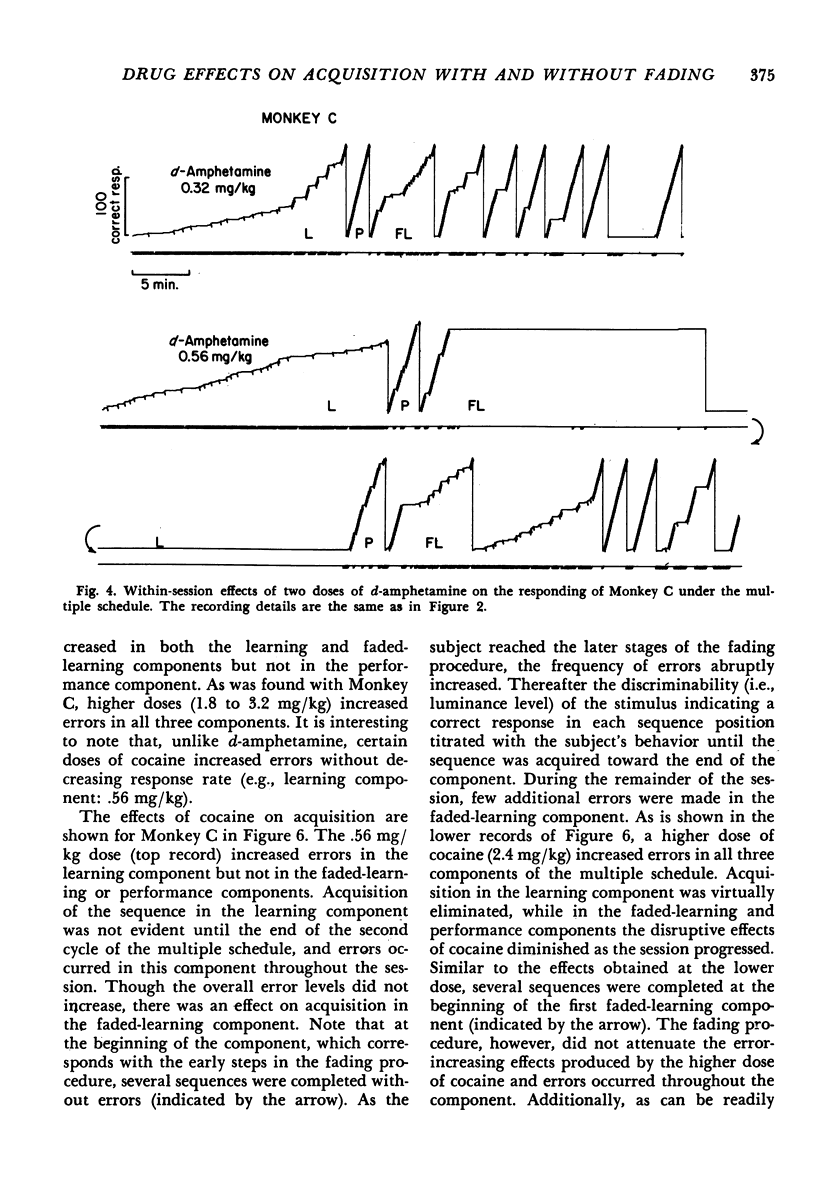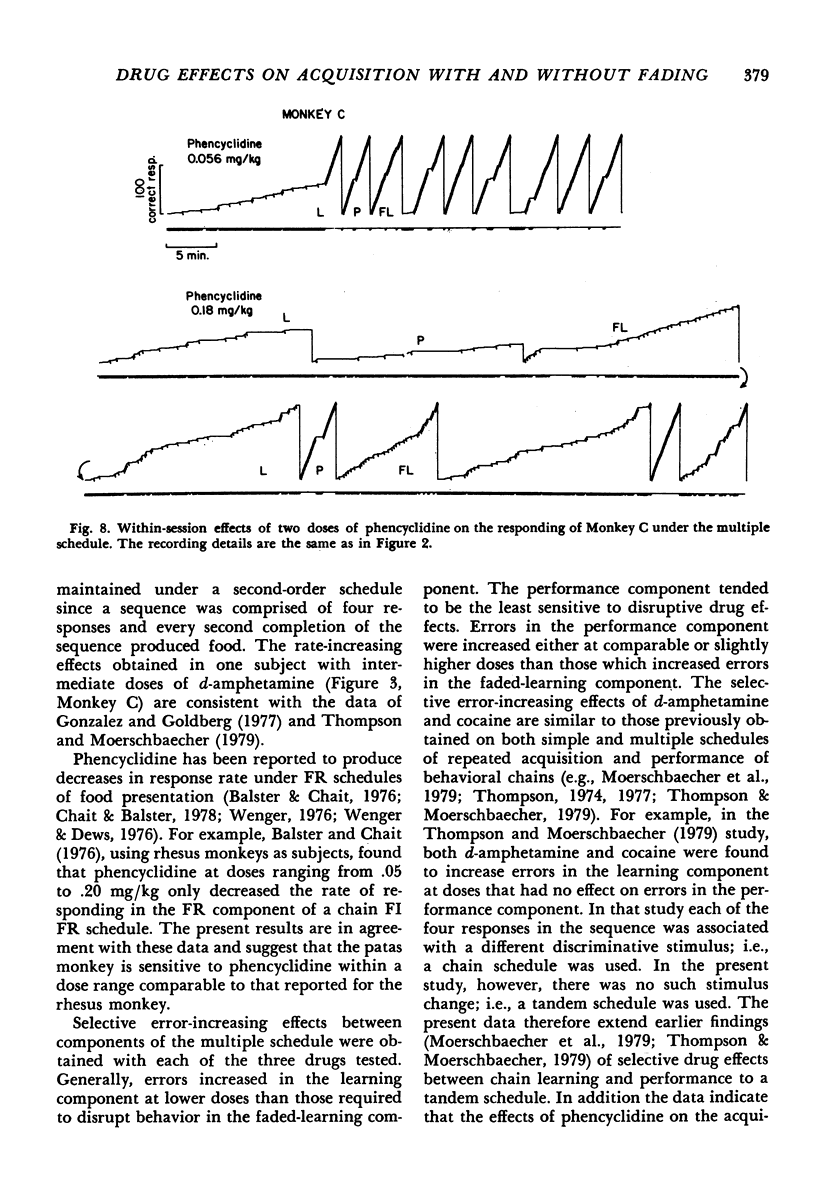Abstract
In each of three components of a multiple schedule, monkeys were required to emit a different sequence of four responses in a predetermined order on four levers. Sequence completions produced food on a fixed-ratio schedule. Errors produced a brief timeout. One component of the multiple schedule was a repeated-acquisition task where the four-response sequence changed each session (learning). The second component of the multiple schedule was also a repeated-acquisition task, but acquisition was supported through the use of a stimulus-fading procedure (faded learning). In a third component of the multiple schedule, the sequence of responses remained the same from session to session (performance). At higher doses, d-amphetamine, cocaine, and phencyclidine decreased the overall rate of responding and increased the percent errors in all three components. At lower doses, however, the three drugs produced selective effects on errors. Errors were increased in the learning component at lower doses than those required to disrupt the behavior in the faded-learning component. The performance component tended to be the least sensitive to disruptive drug effects. The data are consistent with the view that stimulus fading can modulate the effects of drugs on acquisition.
Full text
PDF












Selected References
These references are in PubMed. This may not be the complete list of references from this article.
- Balster R. L., Chait L. D. The behavioral pharmacology of phencyclidine. Clin Toxicol. 1976;9(4):513–528. doi: 10.3109/15563657608988153. [DOI] [PubMed] [Google Scholar]
- Boren J. J., Devine D. D. The repeated acquisition of behavioral chains. J Exp Anal Behav. 1968 Nov;11(6):651–660. doi: 10.1901/jeab.1968.11-651. [DOI] [PMC free article] [PubMed] [Google Scholar]
- Chait L. D., Balster R. L. The effects of acute and chronic phencyclidine on schedule-controlled behavior in the squirrel monkey. J Pharmacol Exp Ther. 1978 Jan;204(1):77–87. [PubMed] [Google Scholar]
- Downs D. A., Woods J. H. Food- and drug-reinforced responding: effects of DITA and d-amphetamine. Psychopharmacologia. 1975 Jul 23;43(1):13–17. doi: 10.1007/BF00437608. [DOI] [PubMed] [Google Scholar]
- Gonzalez F. A., Goldberg S. R. Effects of cocaine and d-amphetamine on behavior maintained under various schedules of food presentation in squirrel monkeys. J Pharmacol Exp Ther. 1977 Apr;201(1):33–43. [PubMed] [Google Scholar]
- Johanson C. E. Effects of intravenous cocaine, diethylpropion, d-amphetamine and perphenazine on responding maintained by food delivery and shock avoidance in rhesus monkeys. J Pharmacol Exp Ther. 1978 Jan;204(1):118–129. [PubMed] [Google Scholar]
- KELLEHER R. T., MORSE W. H. ESCAPE BEHAVIOR AND PUNISHED BEHAVIOR. Fed Proc. 1964 Jul-Aug;23:808–817. [PubMed] [Google Scholar]
- Laties V. G. The role of discriminative stimuli in modulating drug action. Fed Proc. 1975 Aug;34(9):1880–1888. [PubMed] [Google Scholar]
- Moerschbaecher J. M., Boren J. J., Schrot J., Fontes J. C. Effects of cocaine and d-amphetamine on the repeated acquisition and performance of conditional discriminations. J Exp Anal Behav. 1979 Jan;31(1):127–140. doi: 10.1901/jeab.1979.31-127. [DOI] [PMC free article] [PubMed] [Google Scholar]
- Sidman M., Rosenberger P. B. Several methods for teaching serial position sequences to monkeys. J Exp Anal Behav. 1967 Sep;10(5):467–478. doi: 10.1901/jeab.1967.10-467. [DOI] [PMC free article] [PubMed] [Google Scholar]
- Spealman R. D., Goldberg S. R., Kelleher R. T., Goldberg D. M., Charlton J. P. Some effects of cocaine and two cocaine analogs on schedule-controlled behavior of squirrel monkeys. J Pharmacol Exp Ther. 1977 Sep;202(3):500–509. [PubMed] [Google Scholar]
- Thompson D. M. Development of tolerance to the disruptive effects of cocaine on repeated acquisition and performance of response sequences. J Pharmacol Exp Ther. 1977 Nov;203(2):294–302. [PubMed] [Google Scholar]
- Thompson D. M., Moerschbaecher J. M. An experimental analysis of the effects of d-amphetamine and cocaine on the acquisition and performance of response chains in monkeys. J Exp Anal Behav. 1979 Nov;32(3):433–444. doi: 10.1901/jeab.1979.32-433. [DOI] [PMC free article] [PubMed] [Google Scholar]
- Thompson D. M. Repeated acquisition as a behavioral base line for studying drug effects. J Pharmacol Exp Ther. 1973 Feb;184(2):506–514. [PubMed] [Google Scholar]
- Thompson D. M. Repeated acquisition of behavioral chains under chronic drug conditions. J Pharmacol Exp Ther. 1974 Mar;188(3):700–713. [PubMed] [Google Scholar]
- Thompson D. M. Repeated acquisition of response sequences: stimulus control and drugs. J Exp Anal Behav. 1975 May;23(3):429–436. doi: 10.1901/jeab.1975.23-429. [DOI] [PMC free article] [PubMed] [Google Scholar]
- Wenger G. R., Dews P. B. The effects of phencyclidine, ketamine, delta-amphetamine and pentobarbital on schedule-controlled behavior in the mouse. J Pharmacol Exp Ther. 1976 Mar;196(3):616–624. [PubMed] [Google Scholar]
- Wenger G. R. The effect of phencyclidine and ketamine on schedule-controlled behavior in the pigeon. J Pharmacol Exp Ther. 1976 Jan;196(1):172–179. [PubMed] [Google Scholar]
- Wilson M. C., Schuster C. R. Interactions between atropine, chlorpromazine and cocaine on food reinforced behavior. Pharmacol Biochem Behav. 1975 May-Jun;3(3):363–375. doi: 10.1016/0091-3057(75)90044-1. [DOI] [PubMed] [Google Scholar]
- Woods J. H., Tessel R. E. Fenfluramine: amphetamine congener that fails to maintain drug-taking behavior in the rhesus monkey. Science. 1974 Sep 20;185(4156):1067–1069. doi: 10.1126/science.185.4156.1067. [DOI] [PubMed] [Google Scholar]


